Today’s review is a double review of Silk Road Teas’ Golden Monkey Black and Drunken Concubine Zui Gui Tieguanyin Oolong. I jumped at the chance to review something from Silk Road Teas as I’ve heard many good things about them.

Golden Monkey Jin Hou Black Tea
First up is Golden Monkey, aka Jin Hou, a Fujian black tea harvested in March 2018. I seem to not review much black tea these days. Vendors seem happy to send oolong and puer my way, and I haven’t been buying any black tea as my black tea stash is large and ageing.
Leaf and Steeping Method
I wasn’t sure what I was expecting going in, but I was impressed when I saw the leaf on this black tea, as it is gorgeous. This is the good stuff right here – all these gold tips and fine thin leaf. There is a bunch of bag fuzz and its tea smells like malted chocolate milk.
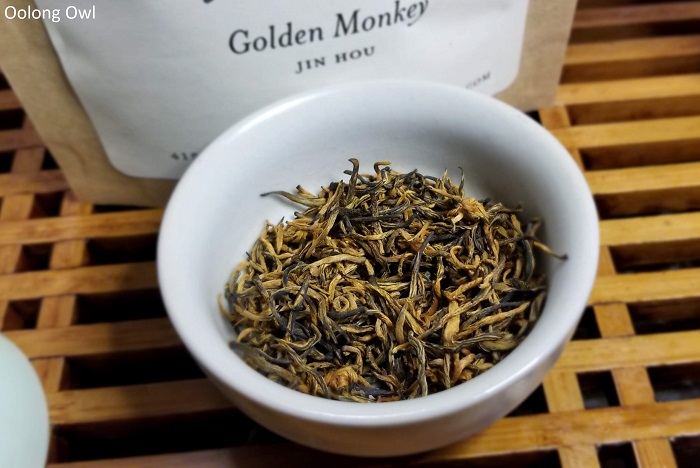
I used 1 gram of leaf per 17ml of vessel size. The ratio sounds weird, but that’s how it plopped out and it looked good. I used gongfu style and boiling water. The hot leaf smells like the darkest of chocolates.
Tasting of Silk Road Tea’s Golden Monkey Jin Hou Black Tea
First, Second, and Third Infusion: Well, the first steep is technically a rinse. I drank it to get lunch out of my mouth and the tea is hella good as a rinse so I counted it as a first infusion. This tea is ballsy. It’s strong, rich, bittersweet dark chocolate at the sip, but then sweetens as the taste left my mouth. The aftertaste is more bittersweet chocolate and slight astringency. Dropping to 200F/ 93c might have helped this tea with the dryness as the leaf is quite delicate, but it is great as is to me.

Fourth and Fifth Infusion: Golden Monkey got fruity. It is has a subtle creamy body making it smooth to drink. The fruit is that raspberry fresh essence, then the sip goes a bit malty, then astringent.
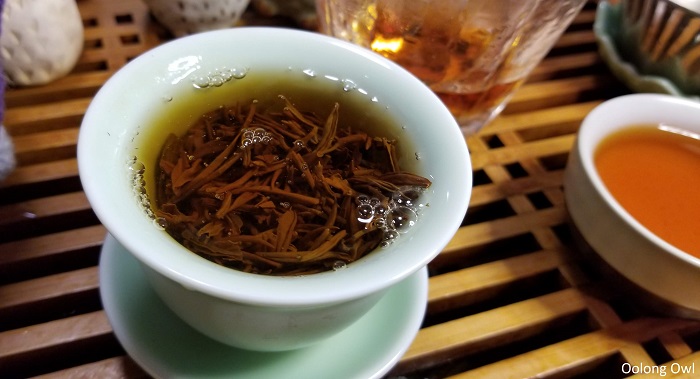
Sixth, Seventh, Eighth, and Ninth Infusion: Golden Monkey slipped hard in flavour. It’s light and mineral tasting on the sixth infusion. For the seventh infusion, I went aggressive and steeped around 5 minutes. It is still light but has a stronger raspberry flavour and lingering raspberry aftertaste. It isn’t sweet like a raspberry, and there’s a bit of malty flavour still peaking out. Golden Monkey is also quite astringent here, drying out my cheeks and tongue. I got a couple more infusions, all getting lighter and more fruity raspberry seedy, but also getting super dry.

Comments
Silk Road Teas’ Golden Monkey is impeccable quality. It is mostly gold and the flavour is nicely complex with bittersweet chocolate, fruit, malt, and minerals.
If you love Chinese golden-tipped black teas, this one has quality and special treat written all over it. Despite gongfu-ing style this tea, I felt like I was at a fancy afternoon tea and need some scones and clotted cream for the side.
Drunken Concubine Zui Gui Tieguanyin Oolong
This Drunken Concubine Tieguanyin oolong is from April 2018 and another Fujian tea.
Leaf and Steeping Method
The leaf on this one is different as it seems like it was partially rolled. Some are rolled, others are not. The fragrance is of strong perfumey flowers.
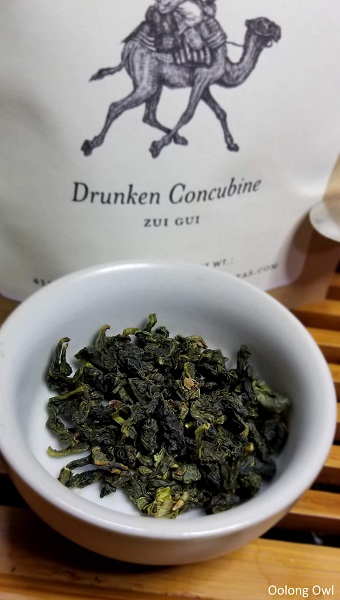
I used 1gram of leaf per 15ml of vessel size, gongfu steeped in boiling water. The hot leaf smells buttery and very perfumey.
Tasting of Silk Road Teas’ Drunken Concubine Zui Gui Tieguanyin Oolong
First and Second Infusion: This oolong is very green. Drunken Concubine Zui Gui Tieguanyin is bright yet also light in profile. The oolong has a sweet floral bouquet going on that blooms in my mouth. There are fresh vegetal elements adding a crispness to the tea. Some sips have a subtle sweet cream buttery. What is impressive about this tea is the salivation drool factor, which is high. I drool after each sip, then I sip again as I rather taste tea than my drool. One con to this oolong is so far it doesn’t linger that long in the aftertaste. There’s a boom of lots of flowers, but it quickly slips to nothing.
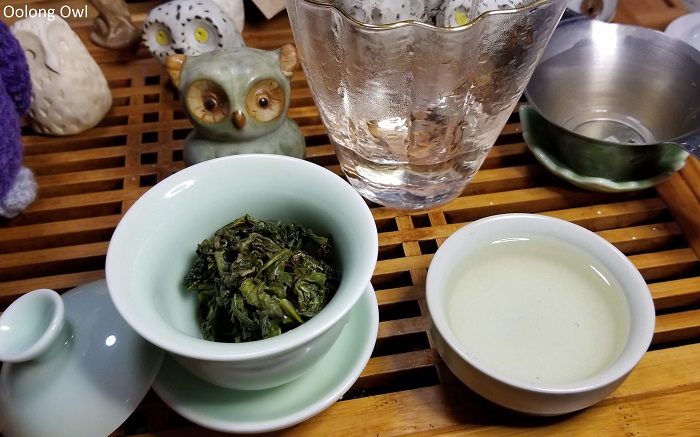
Third and Fourth Infusion: These steepings are just as complex and light. As a reminder, I am boiling the oolong. Drunken Concubine Zui Gui Tieguanyin is still low of flavour, but high on bursty floral aftertaste finish. Some sips on savoury buttered snow peas, others tangy fruity. There is a lot going on in this oolong and it makes it tough as the flavour is soft.
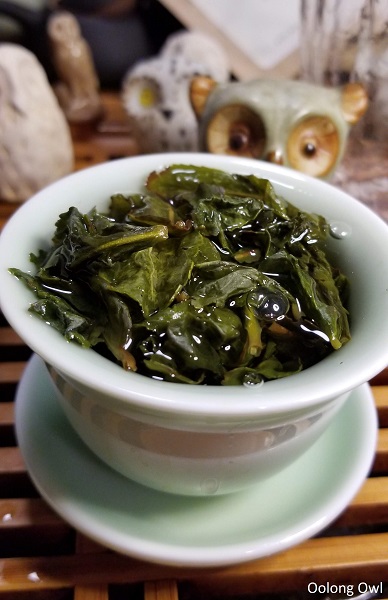
Fifth Infusion: All this time I boiled it and not a lick of dryness. I finally made the tea crack and there’s a bit of astringency at the tip of my tongue. The flavour is waning here, but it’s mostly that sharp bloom of floral aftertaste.


Sixth and Seventh Infusion: I power steeped this going 5 minutes, fresh off the boil and ripping hot gaiwan. Now, this is my favourite steep as it is strong. Drunken Concubine Zui Gui Tieguanyin is a buttery assault of peas and flower bouquets, with a touch of dryness. The dryness makes the floral aftertaste go longer and have a more vegetal flavour. Last round I went 10 minutes and it was moderately dry, but not much in flavour other than stewed floral petals and peas.
Bowl/Grandpa/Western Style: I threw in a couple grams in a bowl and let it steep. I suspect this tea would do better at an extended steep as it can take a boiling beating despite being very green.

After the first minute of steeping Drunken Concubine Zui Gui Tieguanyin sips in sweet and buttery. The flavour profile is stronger than gongfu, but still soft. The longer it goes, the sweeter and more buttery it gets. This oolong has a sweet, milky, buttercup floral flavour without a lick of dryness. 5 minutes in, more typical western steeping amount, and Drunken Concubine Zui Gui Tieguanyin is tangy fruity, nutty and floral. It finally has a touch of dryness but it is soft.
The leaves are big and beautiful!

Comments
I have to admit, I am not a fan of nuclear green Tieguanyin. I was expecting Drunken Concubine Zui Gui Tieguanyin to be a bit more oxidized as all the other ones I have had were. This oolong is perfect for those who prefer a greener oolong that leans more delicate and floral. It does have some abusing power, so you can steep it fairly flexible and it does prefer boiling water. I wouldn’t go under the temperature at the risk of it tasting like nothing.
I would lean western/grandpa as the best steeping method as you get all the flavours at once. Seeing the window of flavour in gongfu the tea is just too subtle and takes a while to break into the magic of oolong and aftertaste.
(tea provided for review)






